Have you ever dreamt of harvesting a cornucopia of fresh, flavorful vegetables right from your backyard? Imagine biting into a juicy tomato still warm from the sun or adding homegrown herbs to elevate your favorite dishes. Creating a thriving garden that yields bountiful harvests doesn’t happen by chance. It all begins with a well-crafted planting schedule tailored to your unique climate and gardening goals.
Whether you’re a seasoned gardener or just starting your green-thumb journey, this comprehensive guide will equip you with the knowledge and tools to design a planting calendar that ensures a flourishing garden year-round. Let’s get started!
Understanding Your Local Climate
Just like you wouldn’t wear a swimsuit in a snowstorm, plants have specific temperature preferences for optimal growth. Your local climate dictates the best time to sow seeds and transplant seedlings.
Hardiness Zones: Your Garden’s Roadmap
The USDA Plant Hardiness Zone Map divides North America into 13 zones based on average minimum winter temperatures. Each zone represents a 10-degree Fahrenheit difference. Knowing your hardiness zone is crucial as it helps determine which plants are most likely to thrive in your area.
Where to Find Your Hardiness Zone: You can easily determine your zone by visiting the USDA Plant Hardiness Zone website or using a gardening app.
Frost Dates: A Gardener’s Best Friend
Frost dates mark the average dates of the last spring frost and the first fall frost in your region. These dates are essential for planning your planting schedule.
- Last Spring Frost Date: This is the date after which it’s generally safe to plant tender crops directly into the ground without the risk of frost damage.
- First Fall Frost Date: This date signals when you should harvest frost-sensitive crops before the cold temperatures arrive.
Tip: You can find your local frost dates by searching online for “[your city] frost dates” or consulting a local gardening center or almanac.
Choosing the Right Plants for Your Schedule
Once you understand your climate, it’s time to select the plants you want to grow.
Cool-Season vs. Warm-Season Vegetables
Vegetables are broadly categorized as cool-season or warm-season based on their temperature preferences:
-
Cool-season vegetables: These hardy plants prefer cooler temperatures and can tolerate light frosts. They’re typically planted in early spring or late summer/early fall. Examples include lettuce, spinach, peas, radishes, and broccoli.
-
Warm-season vegetables: These heat-loving plants thrive in warm soil and air temperatures. They’re usually planted after the last spring frost date. Tomatoes, peppers, cucumbers, beans, and corn are examples of warm-season vegetables.
Days to Maturity: Planning for a Continuous Harvest
When selecting seeds or seedlings, pay close attention to the “days to maturity” listed on the seed packet or plant tag. This number indicates the average number of days it takes for a plant to reach harvest size after being planted. By choosing varieties with different maturity dates, you can enjoy a continuous harvest throughout the growing season.
Creating Your Personalized Planting Calendar
Now, let’s put all the pieces together to build your planting schedule:
-
Gather Your Information:
- Know your hardiness zone.
- Determine your local frost dates.
- Make a list of the vegetables you want to grow.
- Note the days to maturity for each plant.
-
Start Seeds Indoors (Optional):
- If you want to get a head start on the season or grow varieties that require a longer growing time, consider starting seeds indoors 6-8 weeks before your last frost date.
-
Plan for Succession Planting:
- Maximize your harvest by staggering plantings of quick-maturing crops like lettuce and radishes every 2-3 weeks. This ensures a continuous supply of fresh vegetables.
-
Consider Companion Planting:
- Companion planting involves strategically pairing plants that benefit each other. For example, planting basil alongside tomatoes can deter pests and improve tomato flavor.
-
Mark Your Calendar:
- Using a physical calendar, spreadsheet, or gardening app, create a visual representation of your planting schedule.
- Mark your last spring frost date and first fall frost date.
- Plot out when you’ll start seeds indoors, transplant seedlings, and sow seeds directly into the ground.
- Consider factors like days to maturity and succession planting.
Essential Tips for a Successful Planting Schedule
Here are some additional tips to keep in mind:
-
Soil Preparation is Key: Before planting, ensure your soil is well-draining, loose, and rich in organic matter. Amending your soil with compost or other organic materials can significantly boost plant health and productivity.
-
Water Wisely: Different plants have different watering needs. In general, it’s best to water deeply and infrequently, allowing the soil to dry out slightly between waterings.
-
Monitor for Pests and Diseases: Regularly inspect your plants for signs of pests or diseases. Early detection is crucial for effective management.
-
Keep a Garden Journal: Record your planting dates, successes, and challenges in a garden journal. This valuable information will help you refine your planting schedule for future seasons.
Conclusion
Creating a well-planned planting schedule is the foundation for a bountiful and successful garden. By understanding your climate, choosing the right plants, and following these tips, you’ll be well on your way to harvesting a delicious and nutritious bounty from your backyard.
Remember, gardening is a journey of learning and discovery. Don’t be afraid to experiment, observe, and adapt your planting schedule to suit your unique garden space and preferences.
Now that you’re armed with the knowledge to create your planting schedule, it’s time to get your hands dirty and experience the joy of growing your own food! Do you have any favorite garden planning tips? Share them in the comments below!
 Planting Calendar
Planting Calendar
[amazon bestseller=”garden planner”]
